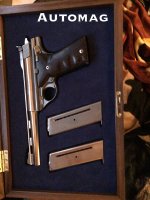Like the "off brand" thread where major manufacturers like Walther and H&K were considered by some to be "off brand", this thread needs a definition of "dead end".
From my perspective, dead end means having no design features that led anywhere.
The Luger's toggle bolt design was interesting and resulted in exceptionally smooth operation, but it was sensitive recoil wise. It was designed for full power ammo and works well only with ammo in a fairly narrow range. However, a well maintained Luger with suitable ammo runs like a well oiled sewing machine and is a joy to shoot. But it led no where and offered nothing in terms of lasting innovation, other than the 9mm Luger round itself.
——
The P08 Luger was replaced but the Walther P38, which was also a dead end configuration wise. However, it's locking system still lives on in the Beretta 92. It can't be called a "dead end", given the long standing use of one or more design elements.
—-
The Browning Hi Power has that in spades as it was the first high capacity semi auto pistol and spawned countless pistols using a double stack magazine. That double column single feed magazine is still state of the art.
Similarly, the Browning linkless delayed recoil locking system is also widely copied and is still found in "modern" pistols. The S&W system is itself a variation on the design.
In terms of the gun itself, the Hi Power was only recently dropped by Browning and is still in production by at least three other companies, so it hasn't been a dead end even from a configuration perspective.
LVSteve is correct that some shooters with meaty hands who also try to use a modern high grip with it my get bit by the hammer, but those same shooters are also not gripping it as it was designed to be gripped. That could be argued as a "dead end" but it can also be addressed with a slight reshaping of the hammer and or the tang.
So I'm not hating on LVSteve for suggesting the Hi Power as a dead end design, but I am thinking of starting a prayer chain for him as he's obviously suffered a stroke or head injury in the last couple days.

——
Browning did launch its share of dead end designs however.
The Browning BDM (Browning Dual Mode) (top) was an interesting designed developed for FBI pistol trials that offered the ability to either be operated in a normal DA/SA pistol mode, or in a DAO revolver mode just by rotating a switch on the slide. It was also clearly intended for concealed carry use, with the thinnest grip I've ever encountered on a double stack magazine pistol. It was a very innovative design that went absolutely no where.
The FN HP-DA (middle) was designed as a double action version of the Hi Power. However, it didn't have much of the feel of a Hi Power, went in a more modern direction style wise, and had no parts, commonality with a Hi Power. It also wasn't innovative in any of its engineering. FN and Browning both introduced it at different times but it never caught on.
The Browning SFS Hi Power (bottom) was an excellent design that offered some of the benefits of DA/SA operation while retaining the SA trigger and cocked and locked condition 1 operation. It was designed for the XM9 trials was but was eliminated for not being a DA/SA pistol. It was slightly redesigned and offered commercially but never met with much success. It's a Mk III Hi Power in all respects, except for the SFS hammer, safety and slide release lever (and the lever is just a cosmetic change). No one has ever picked up the "Safety Fast Shooting" hammer system, making that aspect of it a total dead end. (The hammer profile also eliminated hammer bite as an issue.)






